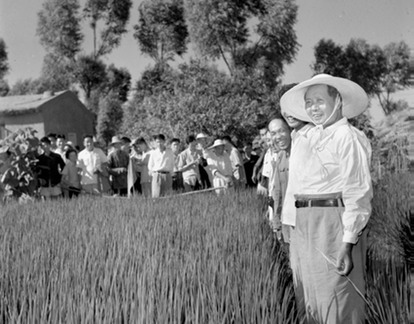Minneapolis Star Tribune, 9 November 2010
Historian's Look at China's Great Famine is Groundbreaking
Historian Frank Dikötter uncovers cannibalism and staggering death numbers in his new look at China's famine.
In a small village in central China, a man was boiling meat. This was strange because it was 1961 and no one had meat. For more than two years they had all been starving, dying, in the largest famine of the 20th century, which killed at least 45 million people, according to new archives used in Frank Dikötter's groundbreaking book, Mao's Great Famine: The History of China's Most Devastating Catastrophe, 1958-1962 (Walker & Co., 448 pages, $30).
The villagers, suspicious, reported the man to local officials, who found a hair clip, ornaments and a scarf belonging to a girl who had disappeared a few days before.
This incident of cannibalism was not isolated. According to Dikötter, human meat was traded on the black market, most of it taken from the plentiful dead, and sometimes mixed with dog meat to disguise it. Yet while this was one of the grislier consequences of Mao Zedong's famine, it was not the most significant.
The history of the 20th century is, in many ways, a battle between ideas and reality, of people trying to impose a vision of what should be onto what is. This was certainly the case with Mao's "Great Leap Forward," undertaken in 1958, with China locked in a bitter race with the Soviet Union over who could reach socialist utopia first.
Based on some glowing (and inflated) crop reports, Mao decreed that the People's Republic of China would embark on a rapid industrialization, and restructuring of the country's agriculture into "people's communes."
Reorganizing society is never simple, and Dikötter found new evidence of the massive and spectacular violence employed to enforce this policy. He estimates that 3 million people were beaten or tortured to death in those years.
The policy was a failure. Villagers watched as party members planted according to ideological principles, but were terrified to offer any criticism. Dikötter has pieced together an elaborate picture of China during this time, with its gulags and state-sponsored violence, disease and suffering. And unlike in other famines, many people actually died of starvation rather than related diseases. His grim estimate pushes the total up from its previous estimate of 30 million, to 45 million, though he says it could be higher still.
Eventually, some party members began to see the catastrophe for what it was, and to confront Mao about it. On a summer afternoon in 1962, Head of State Liu Shaoqi met Mao next to his swimming pool.
"So many people have died of hunger!" Liu told the chairman. "History will judge you and me; even cannibalism will go into the books!"
Dikötter has proven him right.

